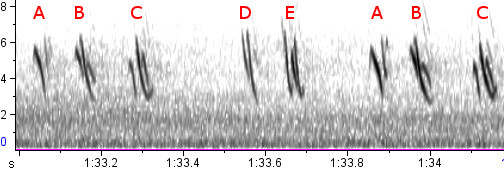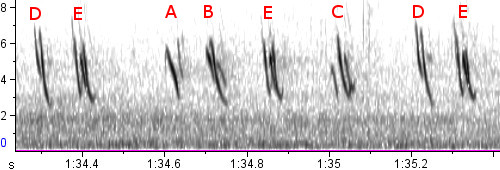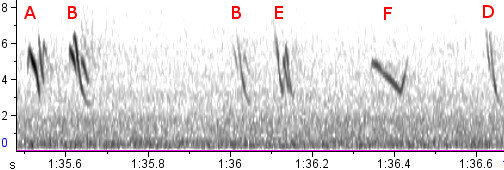Do Violet-green Swallows Sing?

The Violet-green Swallow has long been one of my favorite birds. Perhaps that’s because it is the only one of the seven widespread North American swallow species that I didn’t see regularly when I was growing up in eastern South Dakota. Perhaps it’s the wonderful way that the colors blend on its iridescent back. Perhaps it just reminds me of my beloved Rocky Mountains.
At any rate, most of the reasons I like Violet-green Swallows have always had to do with what they looked like, not what they sounded like. I was fairly familiar with their calls, or so I thought, but I had never really listened to them closely.
Even so, I was astonished to find that the current scientific literature says that Violet-green Swallows don’t sing at all. “I detected no recognizable, repeating series of syllables which could be interpreted as a song,” wrote Charles Brown in a 1983 paper in the Wilson Bulletin. An undergraduate at the time of the research, Brown is now legendary as a swallow researcher, having spent two decades studying Cliff Swallow coloniality in Nebraska. But after writing the BNA account on Violet-green Swallow in 1992, Brown apparently hasn’t published anything further on the species. Nor does anyone else seem to have studied its vocalizations. And so, according to the literature, Violet-green Swallows don’t sing.
Really? No song?
It struck me as unlikely that Violet-green Swallows should lack a song, first because I thought I had heard complex song-like vocalizations from them, and second because the Tree Swallow, a close relative of the Violet-green, definitely sings. It’s rare for one member of a species pair to sing and not the other. (However, it’s not unprecedented. Eastern Bluebirds sing a complex, melodious song; Western Bluebirds reportedly just string call notes together.)
So I went looking through my collection of Violet-green Swallow recordings. Interestingly, most of my recordings matched Brown’s original findings: during the day, the species tends to give three kinds of calls, and even though some of them sound “complex” and I had taken them for song, it appears that none of them are stereotyped–meaning they’re not carbon copies of one another. Instead, each rendition of a call varies slightly from all the others, like in the calls of House Finches or Rosy-Finches. As Brown noted, if these calls were going to be strung together in some kind of song, one would expect to see stereotyped versions, possibly repeated in some kind of predictable pattern.
However, note the caveat in what I said above: during the day. Some swallow species (including Tree Swallow and Purple Martin) sing dawnsongs that apparently differ significantly from anything they say when the sun’s up. Brown’s work did not reveal the existence of a dawnsong in Violet-green Swallow, but it did note the passing mention of “predawn song-flights” in The Birder’s Handbook and “apparent chee-chee calls” starting as early as 2:20 a.m., according to Bent’s Life Histories.
And that led me to a most interesting recording in my collection. At 4:20 in the morning on the 2nd of July, 2008, when the sun was only barely lighting the eastern horizon, I was hiking with a friend up the Loch Vale trail in Rocky Mountain National Park, hoping to reach a Black Swift nesting site before dawn. Just as we reached the Loch, I heard chirping from far overhead, and I immediately turned on my recorder, hoping to catch a Black Swift coming off its night roost. But no: the chirping was too regular, too relentless, not high-pitched or clear enough. The bird was completely invisible as it circled, singing endlessly against a backdrop of stars, but I was pretty sure it was a Violet-green Swallow. Here is a snippet of the recording:
The bird went on like this for at least several minutes without pausing. When I first looked at the spectrogram of the above snippet, it looked like the daytime calls had: a jumble of similar notes, each slightly different than the last, showing no apparent rhyme or reason. But then I zoomed in and started looking very carefully, and sure enough, a pattern emerged:
The calls are stereotyped: all the “A” phrases are basically identical to one another, as are the “B” phrases, etcetera. Furthermore, although the order is variable, there’s a strong tendency to stick to a couple of basic patterns. In other words, this is classic song, crystallized and rule-bound, no matter how disordered it sounds to our slow human ears.
You may not want to give them any prizes for their melody, and you may not even hear them unless you rise long before the sun. But make no mistake: Violet-green Swallows do have a song–one that seems to have gone almost unnoticed until now.



4 thoughts on “Do Violet-green Swallows Sing?”
Your posts are always fascinating, Nathan. I’ve always known that VGSW uttered the very first pre-dawn sounds in western North America in summer (though Cassin’s Kingbirds can beat them to it in SE Arizona). I don’t know whether I ever thought about it as a song or call note though. It’s so cool that we have the most gorgeously colored swallow in the world right here in the western North America, not in some remote tropical location.
Something similar happened to me when reading Birding several years ago (would have to check to see which) where someone wrote that Saltmarsh Sparrow (Ammodramus caudacutus) didn’t sing, whereas Nelson’s Sparrow (A. nelsoni) did. I thought this a strange thing. Only a few months later, I captured Saltmarsh Sparrow singing . It seems it’s not a particularly memorable song, nor very loud, but it’s a song nonetheless.
Now, if only someone could document the true song of the Ecuadorian population of Bicolored Antvireo (Dysithamnus occidentalis punctatectus)!
Excellent post! This matches my experience here in British Columbia, where Violet-green Swallows are typically very vocal in the pre-dawn period throughout the breeding season, commonly beginning around 2 hours before sunrise. In this time, they will typically be circling overhead, giving a continuous, regular series of notes as in your recording – a series of similar-sounding hard “ch-ch” notes with a single stereotyped, clear, descending, Evening Grosbeak-like whistle interspersed at intervals. This whistle somewhat resembles the variable clear whistles that Violet-green Swallows give as aerial predator alarms during the day. I too have noticed that this series appears to be unique to the pre-dawn hours; I have never heard anything sounding like this among Violet-greens’ calls after sunrise, and yet if I’m out 1 hour before sunrise in May and June, in a location where Violet-green Swallows are breeding, without fail, I will hear this stereotyped series drifting down from the dark sky. I have had Violet-green Swallows breeding at my residence, and this occurs every morning through May and June, often continuously for at least 1 hour. If anyone is interested ina a recording of this from Victoria, BC, check out Xeno-Canto, recording # XC65815.
Fascinating post, Nathan! When I was working in the Yukon, I often had them flying over my tent early in the morning. I just assumed what I was hearing was their song. Next time I’m out west I will pay more attention to their vocalizations and try some recordings of my own.
Comments are closed.